seats MERCEDES-BENZ M-Class 2014 W166 Owner's Manual
[x] Cancel search | Manufacturer: MERCEDES-BENZ, Model Year: 2014, Model line: M-Class, Model: MERCEDES-BENZ M-Class 2014 W166Pages: 462, PDF Size: 6.23 MB
Page 5 of 462
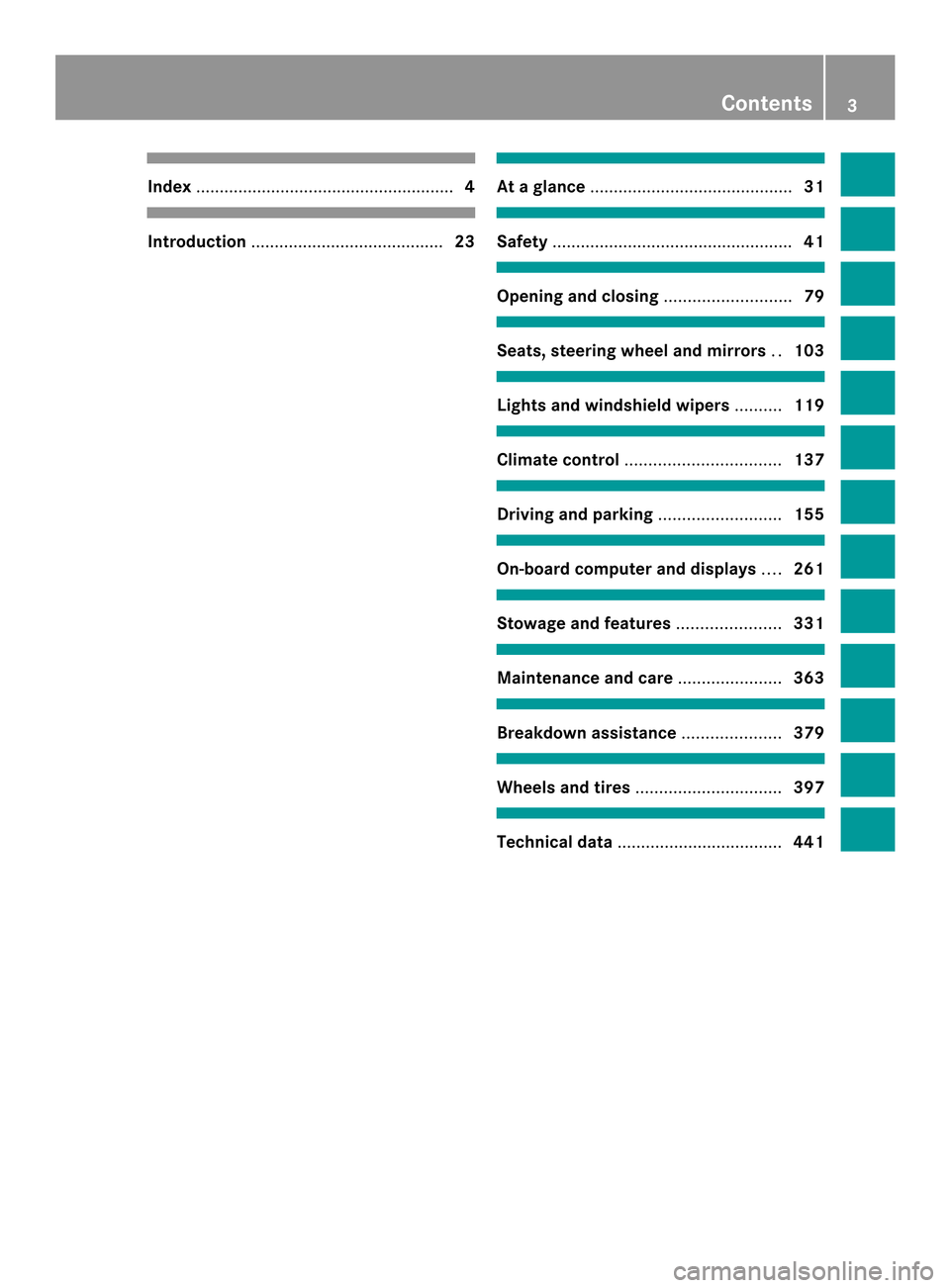
Index
....................................................... 4Introduction
......................................... 23 At
ag lance ........................................... 31 Safety
................................................... 41 Opening and closing
...........................79 Seats, steering wheel and mirrors
..103 Lights and windshield wipers
..........119 Climate control
................................. 137 Driving and parking
..........................155 On-board computer and displays
....261 Stowage and features
......................331 Maintenance and care
......................363 Breakdown assistance
.....................379 Wheels and tires
............................... 397 Technical data
................................... 441 Contents
3
Page 18 of 462
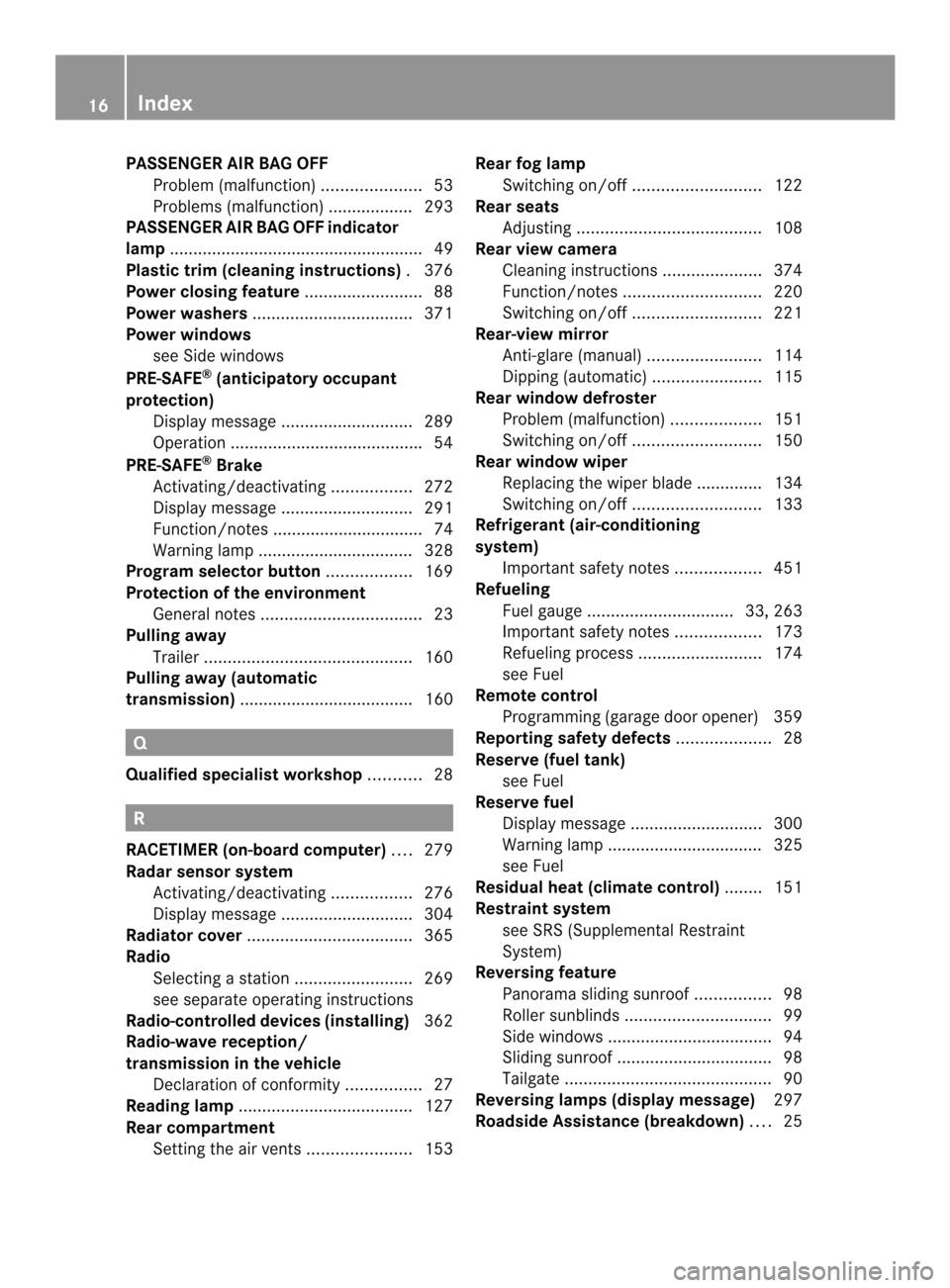
PASSENGER AIR BAG OFF
Problem (malfunction) .....................53
Problems (malfunction) .................. 293
PASSENGE RAIR BAG OFF indicator
lamp ...................................................... 49
Plastic trim (cleaning instructions) .376
Power closing feature .........................88
Power washers .................................. 371
Power windows see Side windows
PRE-SAFE ®
(anticipatory occupant
protection) Display message ............................ 289
Operation ........................................ .54
PRE-SAFE ®
Brake
Activating/deactivating .................272
Display message ............................ 291
Function/notes ................................ 74
Warning lamp ................................. 328
Program selector button ..................169
Protection of the environment General notes .................................. 23
Pulling away
Trailer ............................................ 160
Pulling away (automatic
transmission) ..................................... 160 Q
Qualifie dspecialis tworkshop ...........28 R
RACETIMER (on-board computer) ....279
Radar sensor system Activating/deactivating .................276
Display message ............................ 304
Radiator cover ................................... 365
Radio Selecting astation ......................... 269
see separate operating instructions
Radio-controlled devices (installing) 362
Radio-wave reception/
transmission in the vehicle
Declaratio nofconformity ................ 27
Reading lamp ..................................... 127
Rear compartment Setting the airv ents...................... 153Rear fog lamp
Switching on/off ........................... 122
Rear seats
Adjusting ....................................... 108
Rear view camera
Cleaning instructions .....................374
Function/notes ............................. 220
Switching on/off ........................... 221
Rear-view mirror
Anti-glare (manual )........................ 114
Dipping (automatic) .......................115
Rear window defroster
Problem (malfunction) ...................151
Switching on/off ........................... 150
Rear window wiper
Replacing the wiper blade .............. 134
Switching on/off ........................... 133
Refrigerant (air-conditioning
system)
Important safety notes ..................451
Refueling
Fuel gauge ............................... 33, 263
Important safety notes ..................173
Refueling proces s.......................... 174
see Fuel
Remote control
Programming (garage door opener) 359
Reporting safety defects ....................28
Reserve (fuel tank) see Fuel
Reserve fuel
Display message ............................ 300
Warning lamp ................................. 325
see Fuel
Residual heat (climate control) ........151
Restraint system see SRS (Supplemental Restraint
System)
Reversing feature
Panorama sliding sunroo f................ 98
Roller sunblinds ............................... 99
Side windows ................................... 94
Sliding sunroo f................................. 98
Tailgate ............................................ 90
Reversing lamps (display message) 297
Roadside Assistance (breakdown) ....25 16
Index
Page 19 of 462

Rolle
rsunblind
Panorama roof with power tilt/
sliding panel .................................... .99
Rear side windows .........................345
Roof carrier ........................................ 343
Roof lining and carpets (cleaning
guidelines) ......................................... 377
Roof load (maximum) ........................452
Route (navigation) see Route guidance (navigation)
Route guidance (navigation) ............268 S
Safety Childre ninthe vehicle ..................... 60
Child restraint systems ....................60
Occupant Classification System
(OCS) ............................................... 49
Safety system
see Driving safety systems
Seat belts
Adjusting the driver's and front-
passenger sea tbelt ......................... 57
Adjusting the height ......................... 58
Belt force limiters ............................ 59
Cleaning ......................................... 377
Correct usage .................................. 55
Emergency Tensioning Devices ....... .59
Fastening ......................................... 57
Important safety guidelines .............55
Releasing ......................................... 58
Safety guidelines ............................. 43
Switching belt adjustment on/off
(on-board computer) ......................277
Warning lamp ................................. 317
Warning lamp (function) ................... 58
Seats
Adjusting (electrically). ..................106
Adjusting the head restraint ..........106
Cleaning the cover .........................376
Correct driver's sea tposition ........104
Folding the rear bench seat
forwards/back ............................... 335
Important safety notes ..................105
Overview ........................................ 105
Seat heating problem ....................110
Seat ventilation problem ................111Storing settings (memory function) 117
Switching sea
theating on/off .......109
Switching seat ventilation on/off ..110
Securing hooks .................................. 338
Selector lever Cleaning ......................................... 376
Sensors (cleaning instructions) .......374
Service menu (on-board computer) .273
Service products Brake fluid ..................................... 449
Coolant (engine) ............................ 450
DEF special additive s..................... 447
Engine oil ....................................... 448
Fuel ................................................ 444
Important safety notes ..................444
Refrigerant (air-conditioning
system) .......................................... 451
Washer fluid .................................. .451
Settings
Factory (on-board computer) .........278
On-board computer .......................274
Setting the air distribution ...............148
Setting the airflow ............................148
SETUP (on-board computer) .............279
Side impact air bag .............................47
Side marker lamp (display
message) ............................................ 297
Side marker lamps (changing bulbs) 131
Side windows Cleaning ......................................... 373
Convenience closing feature ............95
Convenience opening feature ..........95
Important safety information ...........93
Opening/closing .............................. 94
Overview .......................................... 93
Problem (malfunction) .....................97
Resetting ......................................... 96
Sliding sunroof
Important safety notes ....................97
Opening/closing .............................. 98
Problem (malfunction) ...................102
Resetting ......................................... 99
see Panorama roof with power
tilt/sliding panel
SmartKey
Changing the battery .......................83
Changing the programming .............81 Index
17
Page 25 of 462
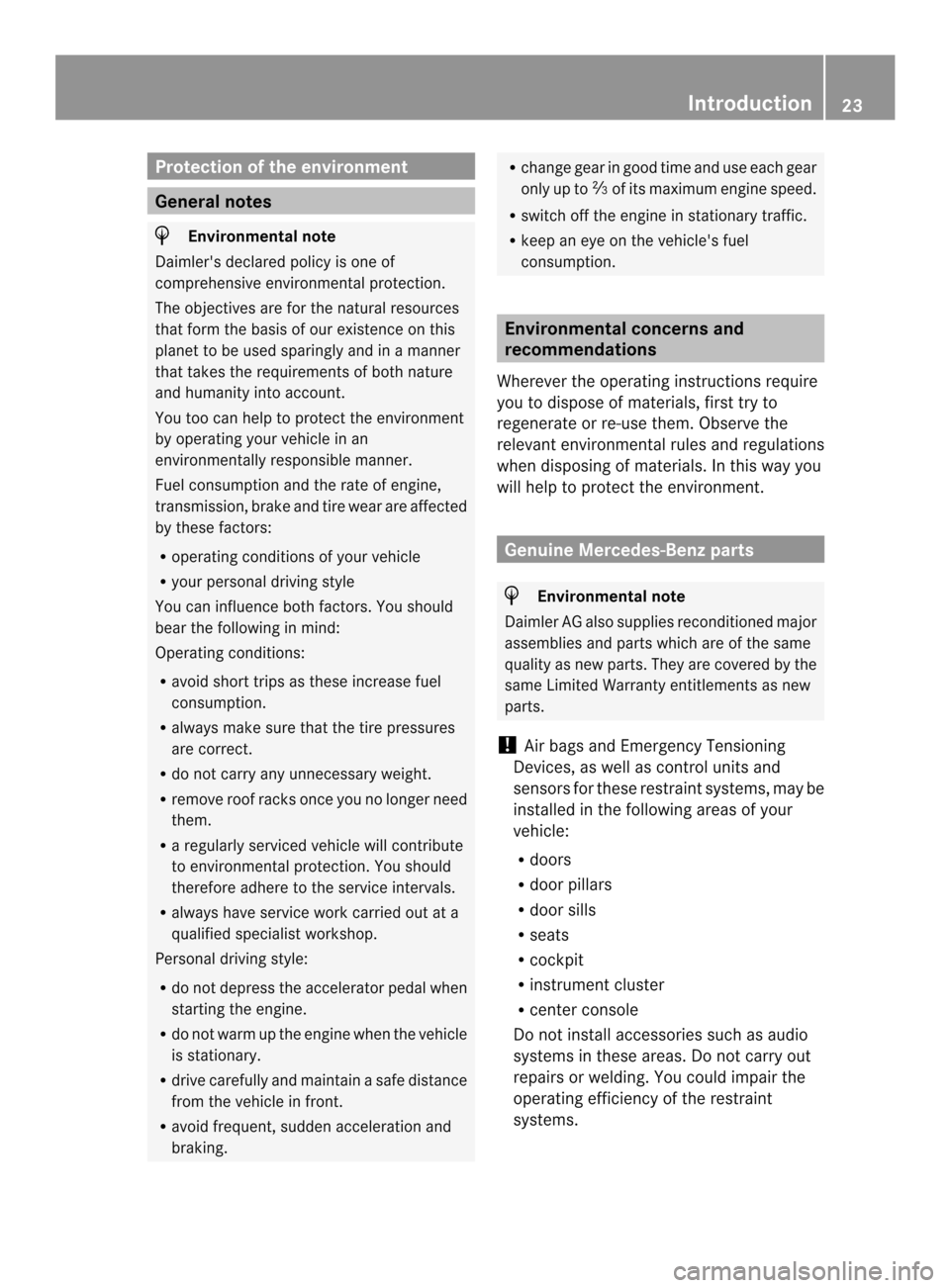
Protection of the environment
General notes
H
Environmental note
Daimler's declared policy is one of
comprehensive environmental protection.
The objectives are for the natural resources
that form the basis of our existence on this
planet to be used sparingly and in a manner
that takes the requirements of both nature
and humanity into account.
You too can help to protect the environment
by operating your vehicle in an
environmentally responsible manner.
Fuel consumption and the rate of engine,
transmission, brake and tire wear are affected
by these factors:
R operating conditions of your vehicle
R your personal driving style
You can influence both factors. You should
bear the following in mind:
Operating conditions:
R avoid short trips as these increase fuel
consumption.
R always make sure that the tire pressures
are correct.
R do not carry any unnecessary weight.
R remove roof racks once you no longer need
them.
R a regularly serviced vehicle will contribute
to environmental protection. You should
therefore adhere to the service intervals.
R always have service work carried out at a
qualified specialist workshop.
Personal driving style:
R do not depress the accelerator pedal when
starting the engine.
R do not warm up the engine when the vehicle
is stationary.
R drive carefully and maintain a safe distance
from the vehicle in front.
R avoid frequent, sudden acceleration and
braking. R
change gear in good time and use each gear
only up to 0001of its maximum engine speed.
R switch off the engine in stationary traffic.
R keep an eye on the vehicle's fuel
consumption. Environmental concerns and
recommendations
Wherever the operating instructions require
you to dispose of materials, first try to
regenerate or re-use them. Observe the
relevant environmental rules and regulations
when disposing of materials. In this way you
will help to protect the environment. Genuine Mercedes-Benz parts
H
Environmental note
Daimler AG also supplies reconditioned major
assemblies and parts which are of the same
quality as new parts. They are covered by the
same Limited Warranty entitlements as new
parts.
! Air bags and Emergency Tensioning
Devices, as well as control units and
sensors for these restraint systems, may be
installed in the following areas of your
vehicle:
R doors
R door pillars
R door sills
R seats
R cockpit
R instrument cluster
R center console
Do not install accessories such as audio
systems in these areas. Do not carry out
repairs or welding. You could impair the
operating efficiency of the restraint
systems. Introduction
23 Z
Page 42 of 462
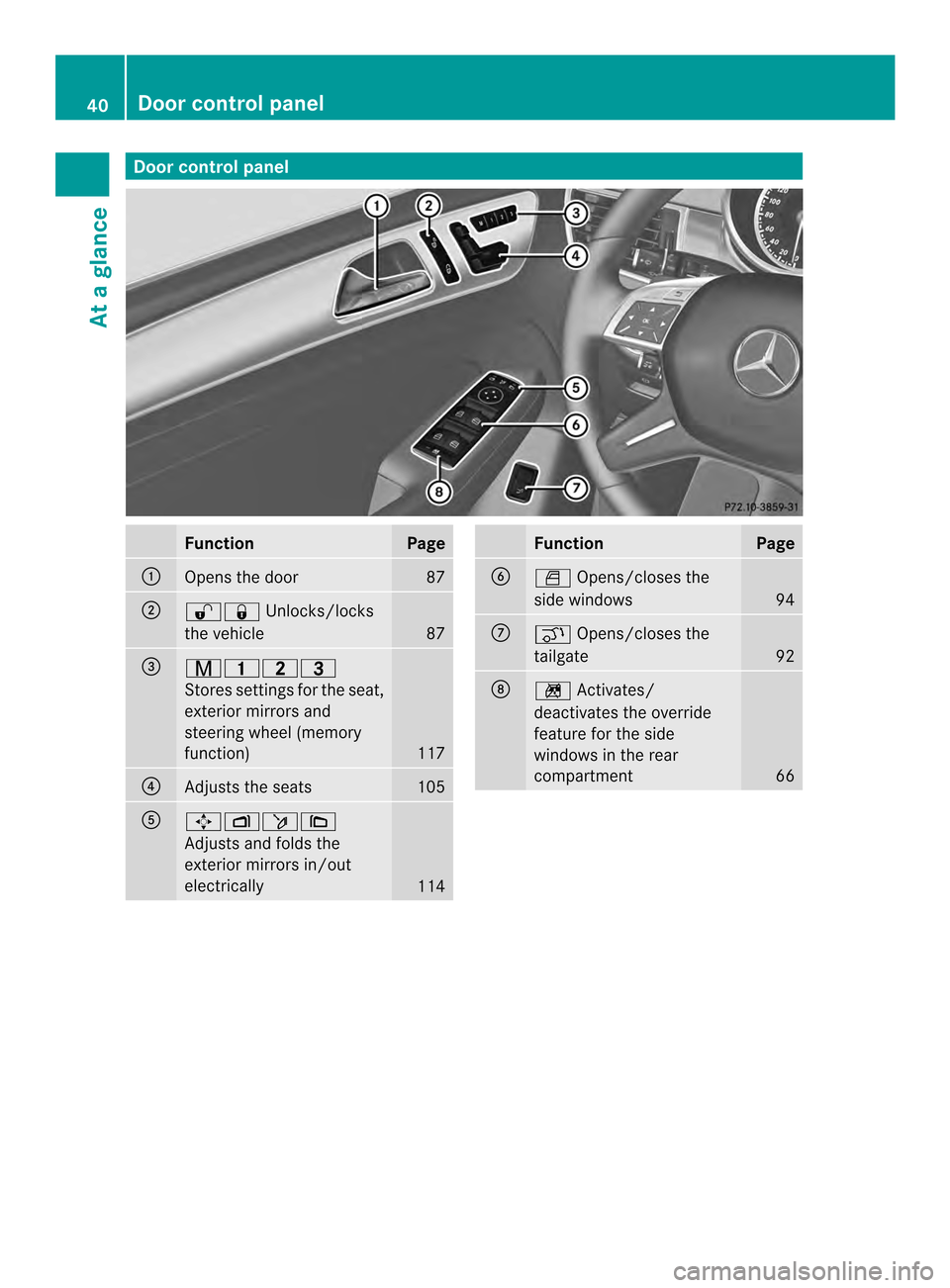
Door control panel
Function Page
0002
Opens the door 87
0003
000C000B
Unlocks/locks
the vehicle 87
0023
00100014000D
Stores settings fo
rthe seat,
exterior mirrors and
steering wheel (memory
function) 117
0022
Adjusts the seats 105
0020
0005000800110009
Adjusts and folds the
exterior mirrors in/out
electrically
114 Function Page
0021
0005
Opens/closes the
side windows 94
0014
000F
Opens/closes the
tailgate 92
0015
000E
Activates/
deactivates the override
feature for the side
windows in the rear
compartment 6640
Doorc
ontrol panelAt a glance
Page 46 of 462
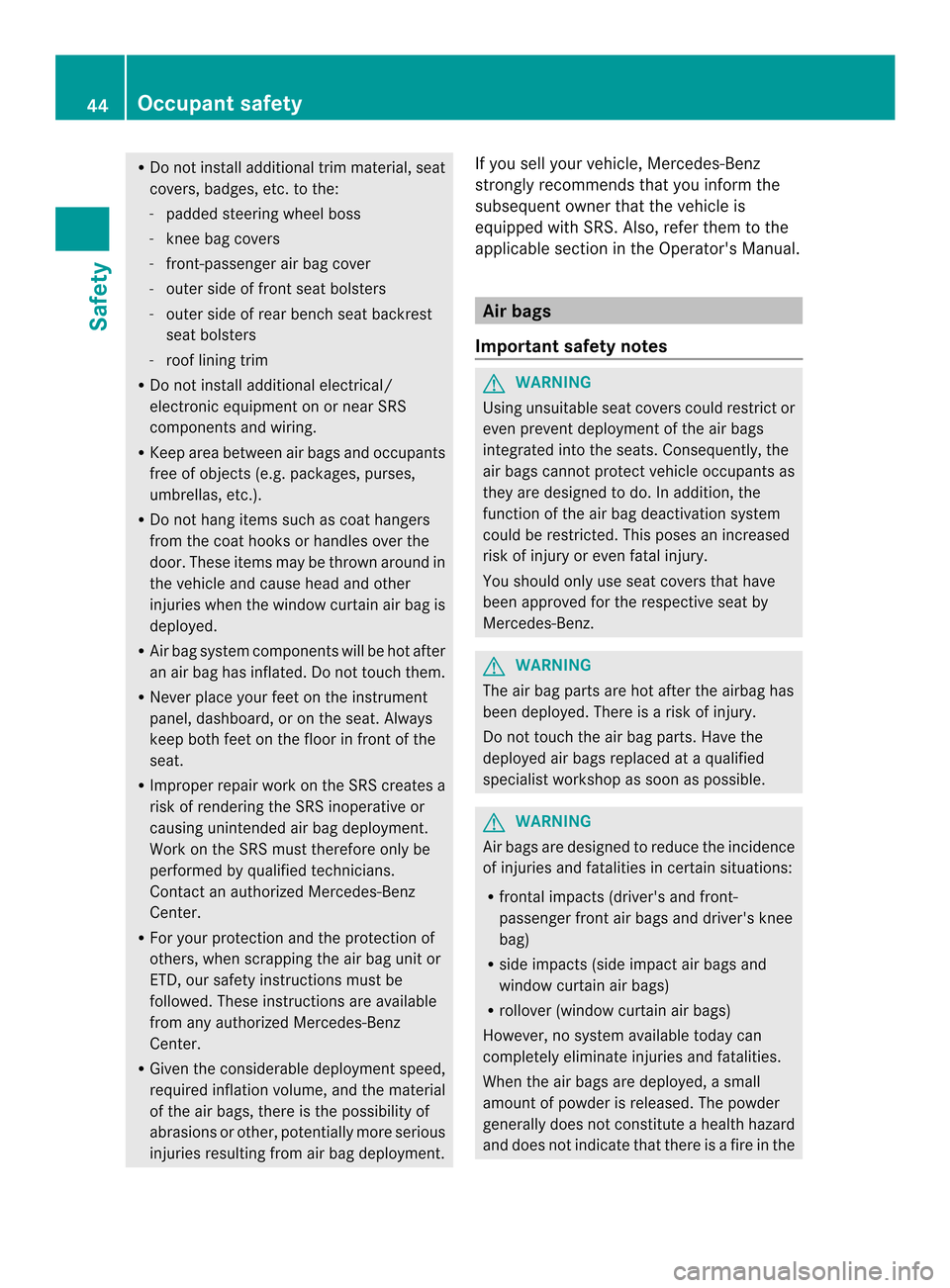
R
Do not install additional trim material, seat
covers, badges, etc. to the:
-padded steering wheel boss
- knee bag covers
- front-passenge rair bag cover
- outer side of front seat bolsters
- outer side of rear bench seat backrest
seat bolsters
- roof lining trim
R Do not install additional electrical/
electronic equipment on or near SRS
components and wiring.
R Keep area betwee nair bags and occupants
free of objects (e.g. packages, purses,
umbrellas, etc.).
R Do not hang items such as coat hangers
from the coat hooks or handles over the
door. These items may be thrown around in
the vehicle and cause head and other
injuries when the window curtain air bag is
deployed.
R Air bag system components will be hot after
an air bag has inflated. Do not touch them.
R Never place your feet on the instrument
panel, dashboard, or on the seat. Always
keep both feet on the floor in front of the
seat.
R Improper repair work on the SRS creates a
risk of rendering the SRS inoperative or
causing unintended air bag deployment.
Work on the SRS must therefore only be
performed by qualified technicians.
Contact an authorized Mercedes-Benz
Center.
R For your protection and the protection of
others, when scrapping the air bag unit or
ETD, our safety instructions must be
followed. These instructions are available
fro ma ny authorized Mercedes-Benz
Center.
R Given the considerable deployment speed,
required inflation volume, and the material
of the ai rbags, there is the possibility of
abrasions or other, potentially more serious
injuries resulting from air bag deployment. If you sell your vehicle
,Mercedes-Benz
strongly recommends that you inform the
subsequent owner that the vehicle is
equipped with SRS. Also, refer them to the
applicable section in the Operator's Manual. Air bags
Important safety notes G
WARNING
Using unsuitable seat cover scould restric tor
even preven tdeployment of the air bags
integrated into the seats. Consequently, the
air bags cannot protec tvehicle occupants as
they are designed to do. In addition, the
function of the air bag deactivation system
could be restricted. This poses an increased
risk of injury or even fatal injury.
You should only use seat covers that have
been approved for the respective seat by
Mercedes-Benz. G
WARNING
The air bag parts are hot after the airbag has
been deployed. There is a risk of injury.
Do not touch the air bag parts. Have the
deployed air bags replaced at a qualified
specialist workshop as soon as possible. G
WARNING
Air bags are designed to reduce the incidence
of injuries and fatalities in certain situations:
R frontal impacts (driver's and front-
passenger fron tair bags and driver's knee
bag)
R side impacts (side impact air bags and
window curtain air bags)
R rollover (window curtain air bags)
However, no system available today can
completely eliminate injuries and fatalities.
When the air bags are deployed, a small
amount of powder is released .The powder
generally does not constitute a health hazard
and does not indicate that there is a fire in the 44
Occupant safetySafety
Page 49 of 462

Front-passenger front air bag
0003will only
deploy if:
R the system, based on the OCS weight
senso rreadings, has detected that the
front-passenger seat is occupied.
R the PASSENGER AIRBAG OFF indicator
lamp on the center console is not lit.
(Y page 49)
R the air bag control unit predicts a high
impact severity.
Driver's knee bag Driver's knee bag
0002deploys under the
steering column. The driver's knee bag is
always deployed along with the driver's front
air bag. The driver's knee bag is designed to
operate together with the fron tair bags in
frontal impacts if certain thresholds are
exceeded. The driver's knee bag operates
best in conjunction with correctly positioned
and fastened seat belts.
The driver's knee bag increases protection of
the drive ragainst:
R knee injuries
R thigh injuries
R lower leg injuries
Side impact air bags G
WARNING
Using unsuitable seat covers could restric tor
even preven tdeployment of the air bags
integrated into the seats. Consequently, the
air bags cannot protec tvehicle occupants as they are designed to do. In addition, the
function of the air bag deactivation system
could be restricted. This poses an increased
risk of injury or even fatal injury.
You should only use seat covers that have
been approved for the respective seat by
Mercedes-Benz.
G
WARNING
Sensors to control the air bags are located in
the doors. Modifications or work not
performed correctly to the doors or door
paneling, as well as damaged doors, can lead
to the function of the sensors being impaired.
The air bags might therefore not function
properly any more. Consequently, the air bags
cannot protec tvehicle occupants as they are
designed to do. There is an increased risk of
injury.
Never modify the doors or parts of the doors.
Always have work on the doors or door
paneling carried out at a qualified specialist
workshop.
You should only use seat covers that have
been approved for your vehicle by Mercedes-
Benz .The seat covers must have a special
tear seam for side impact air bags. Otherwise,
the side impact air bags cannot deploy
correctly and therefore cannot provide the
intended protection in the event of an
accident. Front side impact air bags
0002and rear side
impact air bags 0003deploy next to the outer
seat cushions. Occupant safety
47Safety Z
Page 50 of 462

When deployed, the side impact air bags offer
additional protection for the thorax and, on
the fron tseats, the pelvis of the vehicle
occupants on the side of the vehicle on which
the impact occurs. However, they do not
protect the:
R head
R neck
R arms
The side impact air bags are deployed:
R on the side on which an impact occurs
R at the start of an accident with a high rate
of lateral vehicle deceleration or
acceleration, e.g. in aside impact
R regardless of whether the seat belt on the
driver's seat and the outer seats of the 2nd
row of seats is used
R independently of the front air bags
R independently of the ETDs
If the vehicle rolls over, the side impac tair
bags are generally not deployed. side impact
air bags are deployed if the system detects
high vehicle deceleration or acceleration in a
lateral direction, or also if the vehicle rolls
over, and the system determines that side
impac tair bag deploymen tcan offer
additional protection to that provided by the
seat belt.
Side impac tair bags will not deploy in side
impacts which do not exceed the system's
prese tdeployment thresholds for lateral
acceleration/deceleration .You will then be
protected by the fastened seat belt.
The side impact air bag on the front-
passenger side is not deployed in the
following situations:
R the OCS system detects that the front-
passenger seat is not occupied, and
R the front-passenger seat belt is not
fastened.
The side impact air bag on the front-
passenger side will deploy if the front-
passenger seat belt is fastened, regardless of whether the front-passenger seat is occupied
or not.
Window curtain air bags
Window curtain air bags
0002enhance the level
of protection for the head, but not chest or
arms, of the vehicle occupants on the side of
the vehicle on which the impact occurs.
The window curtain air bags are integrated
into the side of the roof frame and deploy in
the area from the A-pillar to the C-pillar.
Window curtain air bags are deployed:
R at the start of an accident with a high rate
of lateral vehicle deceleration or
acceleration, e.g. in aside impact
R on the side on which an impac toccurs
R on the driver's side and passenger side, in
the event of a vehicle rollover and if the
system determines that ai rbag deployment
can offer the vehicle occupants additional
protection to that provided by the seat belt
R independently of the use of the seat belt
R regardless of whether the front-passenger
seat is occupied
R independently of the fron tair bags
Window curtain air bags 0002will not deploy in
the even tofimpacts which do not exceed the
system's preset deployment thresholds for
vehicle acceleration/deceleration. You will
then be protected by the fastened seat belt. 48
Occupant safetySafety
Page 51 of 462

Occupant Classification System
(OCS)
Method of operation G
WARNING
If the 001A001C indicator lamp illuminates
when an adult or someone larger than a small
individual is in the fron tpassenger seat, have
the fron tpassenger reposition himself or
herself in the seat until the 001A001C
indicator lamp goes out.
In the event of a collision, the air bag control
unit will no tallow front passenger front air bag
deploymen twhen the OCS has classified the
front passenger seat occupant as weighing as
much as or less than a typical 12-month-old
child in a standard child restraint or if the front
passenger seat is classified as being empty.
When the OCS senses that the front
passenger seat occupant is classified as
being up to or less than the weight of a typical
12-month-old child in a standard child
restraint, the 001A001Cindicator lamp will
illuminate when the engine is started and
remain illuminated. This indicates that the
front passenger front air bag is deactivated.
When the OCS senses that the front
passenger seat is classified as being empty,
the 001A001C indicator lamp will illuminate
when the engine is started and remain
illuminated. This indicates that the front
passenger front air bag is deactivated.
When the OCS senses that the front
passenger seat occupant is classified as
being heavier than the weight of a typical 12-
month-old child seated in astandard child
restraint or as being a small individual (such
as a young teenager or asmall adult), the
001A001C indicator lamp will illuminate for
approximately 6seconds when the engine is
started. Depending on occupant weight
sensor readings from the seat, it will then
remain illuminated or go out. With the
001A001C indicator lamp illuminated, the
fron tpassenger fron tair bag is deactivated. With the
001A001C indicator lamp out, the
front passenger front air bag is activated.
When the OCS senses that the front
passenger seat occupant is classified as an
adult or someone larger than a small
individual, the 001A001Cindicator lamp will
illuminate for approximately six seconds
when the engine is started and the ngo out.
This indicates that the front passenger front
air bag is activated.
If the 001A001C indicator lamp is illuminated,
the front passenger front air bag is
deactivated and will not be deployed.
If the 001A001C indicator lamp is not
illuminated, the front passenger front air bag
is activated and will be deployed
R in the event of certain frontal impacts
R if the impact exceeds a predetermined
triggering threshold
R independent of the side impact air bag or
pelvis air bag
If the front passenger front air bag is
deployed, the rate of inflation will be
influenced by
R the rate of vehicle deceleration as assessed
by the air bag control unit
R the front passenger's weight category as
identified by the OCS G
WARNING
According to accident statistics, children are
safer when properly restrained on the rear
seats than on the front-passenger seat. Thus,
we strongly recommend that children be
placed in the rear seats whenever possible.
Regardless of seating position, children 12
years old and under must be seated and
properly secured in an appropriate infant
restraint, toddler restraint, or booster seat
recommended for the size and weight of the
child.
The infant or child restraint must be properly
secured with the vehicle's seat belt, the seat
belt and Top Tether strap, or lower anchors Occupant safety
49Safety
Z
Page 56 of 462
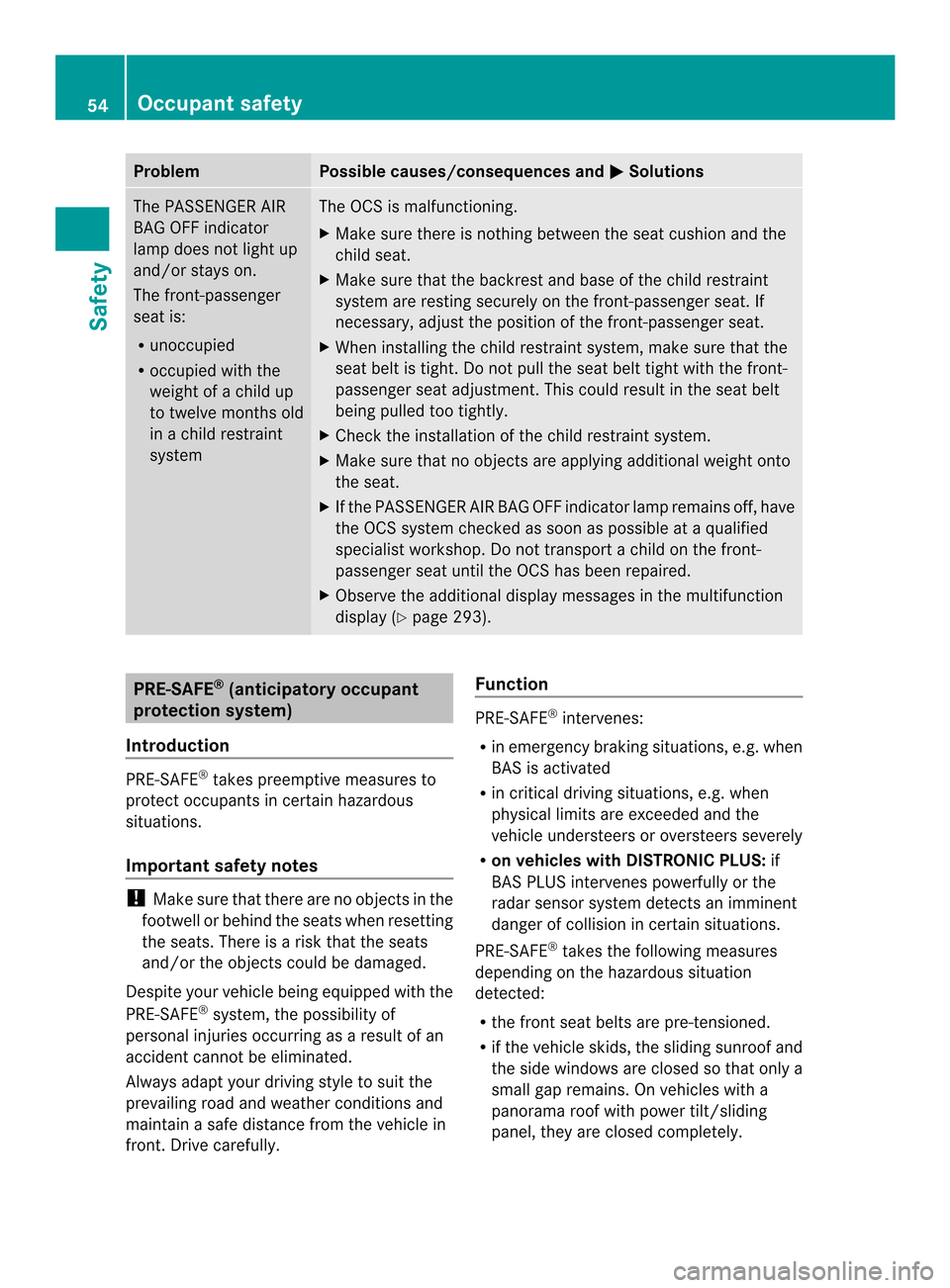
Problem Possible causes/consequences and
0001 Solutions
The PASSENGER AIR
BAG OFF indicator
lamp does not light up
and/or stays on.
The front-passenger
seat is:
R
unoccupied
R occupied with the
weight of a child up
to twelve months old
in a child restraint
system The OCS is malfunctioning.
X
Make sure there is nothing between the seat cushion and the
child seat.
X Make sure that the backrest and base of the child restraint
system are resting securely on the front-passenger seat. If
necessary, adjust the position of the front-passenger seat.
X When installing the child restraint system, make sure that the
seat belt is tight. Do not pull the seat belt tight with the front-
passenger seat adjustment .This could result in the seat belt
being pulled too tightly.
X Check the installation of the child restraint system.
X Make sure that no objectsa re applying additional weight onto
the seat.
X If the PASSENGER AIR BAG OFF indicator lamp remains off, have
the OCS system checked as soon as possible at a qualified
specialist workshop .Do not transport a child on the front-
passenger seat until the OCS has been repaired.
X Observe the additional display messages in the multifunction
display (Y page 293). PRE-SAFE
®
(anticipatory occupant
protection system)
Introduction PRE-SAFE
®
takes preemptive measures to
protect occupants in certain hazardous
situations.
Important safety notes !
Make sure that there are no objects in the
footwell or behind the seats when resetting
the seats. There is a risk that the seats
and/or the objects could be damaged.
Despite your vehicle being equipped with the
PRE-SAFE ®
system, the possibility of
personal injuries occurring as a result of an
accident cannot be eliminated.
Always adapt your driving style to suit the
prevailing road and weather conditions and
maintain a safe distance from the vehicle in
front. Drive carefully. Function PRE-SAFE
®
intervenes:
R in emergency braking situations, e.g. when
BAS is activated
R in critical driving situations, e.g. when
physical limits are exceeded and the
vehicle understeers or oversteers severely
R on vehicles with DISTRONIC PLUS: if
BAS PLUS intervenes powerfully or the
radar sensor system detect sanimminent
dange rofcollision in certain situations.
PRE-SAFE ®
takes the following measures
depending on the hazardous situation
detected:
R the front seat belts are pre-tensioned.
R if the vehicle skids, the sliding sunroof and
the side windows are closed so that only a
small gap remains. On vehicles with a
panorama roof with power tilt/sliding
panel, they are closed completely. 54
Occupant safetySafety